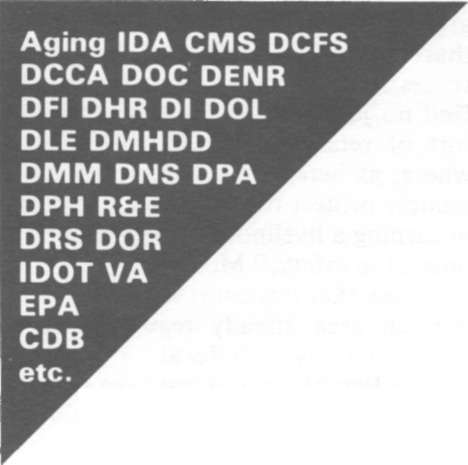 |
Home | Search | Browse | About IPO | Staff | Links |
 |
Home | Search | Browse | About IPO | Staff | Links |
|
Executive Report  Federal funds for fighting crime ILLINOIS' $2.3 million first-year share of funds provided by the federal Justice Assistance Act will be spent on a four-part program to improve criminal justice systems at state and local levels. State and local governments are to match the federal funds. Guidelines were being drafted in December to determine how to spend an additional $1.8 million in federal funds to aid crime victims, according to an Illinois Criminal Justice Authority spokeswoman. The breakdown of the $2.3 million: • $1,185 million to create a computer system to track inmates at up to 10 county jails; automate operations at about 20 state's attorney's offices; expand the Police Information Management System; and provide computer training and technical assistance in these areas. • $750,000 to help Cook County law enforcement authorities modernize a fingerprint identification network in the suburbs; upgrade the State Police's fingerprint transmission network that distributes fingerprint information throughout the state; and allow the Chicago Police Department to expand "rap sheets," which document a person's criminal record. • $250,000 for a public information campaign featuring McGruff.the crime dog, to encourage the public to get involved with crime prevention efforts. • $100,000 to train state's attorneys to prosecute drug dealers, career criminals and domestic violence and sexual abuse offenders. Training also will be available to crime prevention officers, citizen volunteers and other specialized groups. Marc D. Allan Hiring veterans for state jobs GOV. James R. Thompson announced in November a more vigorous program to hire veterans for state jobs. That program was implemented shortly after the governor had instituted a hiring freeze, leaving the number of veterans to be hired unknown, according to Central Management Services (CMS). Robert H. Tapscott, bureau manager of personnel for CMS in Springfield, said he could not estimate how the hiring freeze would affect the veterans' hiring program. But if the freeze were not in effect, the state might hire about 660 additional veterans compared to previous years, Tapscott said. Over the past three years, the state has hired an average of 6,000 people each year. Of those, an average of 1,140 have been veterans. Without the freeze, veteran hiring likely would be increased to 1,800 this year, Tapscott said. He added that the freeze would not hurt veterans any more than any other group. The governor's program is based on the number of people expected to be hired for a given position and the number of veterans applying. For position titles that have an anticipated hiring rate of 10 or more people a year, the following criteria apply: • When veterans constitute at least 10 percent of those eligible to be hired, at least 50 percent of the people hired must be veterans. • When veterans comprise 4 percent to 9 percent of those eligible to be hired, veterans must constitute at least 25 percent of those hired. • When veterans constitute 1 percent to 3 percent of those eligible to be hired, at least 15 percent of those hired must be veterans. For position titles that have an annual anticipated hiring rate of nine or fewer, 20 percent of those hired must be veterans regardless of how many veterans are eligible. Marc D. Allan 26/January 1986/Illinois Issues |
|
|